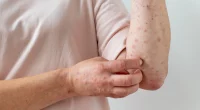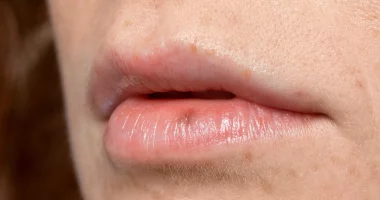Barrett’s esophagus is a condition where the inner wall of the esophagus changes. Instead of its normal lining, the esophagus develops tissue that looks like the lining of the intestine.
The esophagus is a tube-like structure that carries food from your mouth to your stomach. When this tissue change happens, it’s called intestinal metaplasia.
The exact cause of Barrett’s esophagus is unknown, but it affects about 1.6 to 3 out of every 100 people.
Individuals with Barrett’s esophagus have a higher chance of getting a type of cancer called esophageal adenocarcinoma, though this cancer is still rare. As stated by the National Institute of Diabetes and Digestive and Kidney Diseases (NIDDK), only about 0.5 percent of individuals with Barrett’s esophagus get this cancer each year.
Barrett’s esophagus is most commonly found in people who have had gastroesophageal reflux disease (GERD) for a long time.
Symptoms
Many people with Barrett’s esophagus also experience symptoms of gastroesophageal reflux disease (GERD). These signs include heartburn, which is a burning feeling in the chest, and dysphagia, where a person has difficulty swallowing food. Additionally, they might feel chest pain, characterized by burning and discomfort back of the ribcage.
However, the majority of people with Barrett’s esophagus do not face any symptoms at all.
Diet
Certain drinks and foods can trigger gastroesophageal reflux disease (GERD), which can eventually cause Barrett’s esophagus. By eliminating these triggers from their diets, people can decrease their symptoms.
Drinks and foods that can cause inflammation in the esophagus include caffeine drinks, fatty foods, peppermint, chocolate, oily and spicy foods, tomato-based products, and alcohol.
In addition to avoiding these triggers, eating small and frequent meals instead of three large meals can help reduce GERD symptoms.
Risk factors
Certain sets of people have a higher chance of developing Barrett’s esophagus. As stated by the NIDDK, between 5 and 10 percent of individuals with GERD have this condition.
Those at an increased risk include people who are overweight or obese, individuals who have been affected with GERD for more than five years, and those who are age 50 are taking regular medication for GERD. People who smoke tobacco are also at a higher risk, as are those who develop chronic GERD before the age of 30. Additionally, men are twice as likely to develop Barrett’s esophagus compared to women.
However, some factors may decrease the chance of developing Barrett’s esophagus. The NIDDK recommends that individuals with a bacterial infection called Helicobacter pylori (H. pylori) have a lower occurrence of Barrett’s esophagus. Despite this, H. pylori can cause stomach ulcers and give rise to stomach cancer. Overutilization of aspirin or other anti-inflammatory medicines can also raise the problem of stomach ulcers. Following a diet high in fruits, vegetables, and vitamins may help lower the risk of Barrett’s esophagus.
Causes
The important cause of Barrett’s esophagus is acid reflux. It happens when stomach acid or bile flows back into the esophagus, the tube that connects your mouth to your stomach. This backflow can cause irritation and inflammation in the esophagus, leading to a condition known as gastroesophageal reflux disease (GERD).
When GERD is long-lasting, it can damage the lining of the esophagus. Over time, this damage can cause the normal esophageal lining to be replaced with tissue similar to that of the intestine, resulting in Barrett’s esophagus. About 10 percent of individuals who have acid reflux develop Barrett’s esophagus.
Diagnosis
As stated by the National Institute of Diabetes and Digestive and Kidney Diseases (NIDDK), Age of 55 is the average age to diagnose Barrett’s esophagus.
To determine this condition, doctors often recommend an endoscopy for people showing signs of acid reflux. An endoscopy involves inserting a tiny, flexible tube with a camera and light at the end into the food pipe, stomach, and intestine. This allows doctors to look inside and check for any changes in the inner walls of the esophagus that might specify Barrett’s esophagus.
If Barrett’s esophagus is suspected or diagnosed, doctors use endoscopy to observe the condition regularly. This typically involves:
- An endoscopy after one year, followed by every three years if no tissue modifications are shown.
- An endoscopy between six months and one year after diagnosis if mild tissue modifications are present.
During the endoscopy, the doctor may take a tissue piece, called a biopsy, to examine under a microscope. This is usually done under mild sedation to keep the patient comfortable.
Taking a biopsy that represents the entire esophagus lining can be challenging because not all areas may show signs of Barrett’s esophagus. To get a thorough examination, the doctor usually takes at least 8 biopsies during the process.
Normal esophageal tissue looks glossy and pale, while tissue affected by Barrett’s esophagus appears velvety and red. These visual differences help doctors identify and diagnose the condition.
Treatment
The treatment for Barrett’s esophagus relies upon the severity of the tissue modifications and the overall health of the patient.
For No or Mild Tissue Changes
- Treatment to Control GERD: Doctors often prescribe medications to manage gastroesophageal reflux disease (GERD), which can help slow the progression of Barrett’s esophagus by reducing stomach acid that might damage the esophagus.
- Surgery: In some cases, surgery may be recommended to harden the muscle at the lower end of the esophagus, preventing stomach acid from getting away.
For severe or acute Tissue Changes
More advanced tissue changes require more intensive treatments, including:
- Endoscopic Resection: This procedure involves eliminating abnormal cells using an endoscope, a thin, flexible tube with a camera and light.
- Radiofrequency Ablation: Surgeons use radio waves to generate heat and destroy abnormal tissue.
- Cryotherapy: This treatment involves applying a cold gas or liquid to freeze and then thaw abnormal cells, which damages the Barrett’s tissue.
- Photodynamic Therapy: This process makes abnormal cells responsive to light using a light-activated chemical known as profimer. The doctor then utilizes a laser to eliminate these cells.
- Endoscopic Mucosal Resection: Similar to endoscopic resection, this procedure removes abnormal tissue and can be combined with photodynamic therapy for better results.
- Esophagectomy: In severe cases, the surgeon removes the affected areas of the esophagus entirely and reconstructs the esophagus using parts of the small intestine or stomach.
Medications for GERD
To treat GERD, healthcare providers often prescribe proton pump inhibitors (PPIs), which reduce the amount of acid produced by the stomach. Common PPIs include:
- Esomeprazole
- Lansoprazole
- Omeprazole
These medications help to manage GERD symptoms and prevent further damage to the esophagus, potentially slowing the progression of Barrett’s esophagus.
Lifestyle Changes
To decrease symptoms of GERD and lower the chance of developing Barrett’s esophagus, individuals can make several lifestyle changes:
- Maintain a Healthy Weight: Keeping a healthy weight can help reduce pressure on the stomach and lower the risk of acid reflux.
- Avoid Tight-Fitting Clothes: Wearing loose clothing can prevent unnecessary pressure on the abdomen.
- Ceasing Smoking: Smoking can increase acid production and weaken the esophageal sphincter, leading to more frequent acid reflux.
- Avoid Lying Down or Bending After Eating: Remaining upright after meals helps prevent stomach acid from flowing back into the esophagus.
- Raise the Head of the Bed: Elevating the bed’s head by 6 to 8 inches with wooden blocks can help keep stomach acid down while sleeping.
Anyone experiencing GERD symptoms or concerned about their chance of Barrett’s esophagus should speak with their doctor for personalized advice and potential treatment options.
Summary
Barrett’s esophagus is a condition where the esophageal lining changes to resemble the intestinal lining, often due to long-term GERD. Diagnosis typically involves an endoscopy, and treatment varies based on tissue changes, ranging from medication and lifestyle changes to surgical interventions.
Lifestyle adjustments like maintaining a healthy weight, avoiding tight clothing, quitting smoking, and elevating the bed can help manage GERD and reduce Barrett’s risk. Advanced cases may require procedures like endoscopic resection, radiofrequency ablation, or esophagectomy. Medications such as proton pump inhibitors are commonly prescribed to control GERD. Regular monitoring and consultation with healthcare providers are essential for managing the condition.
External links









